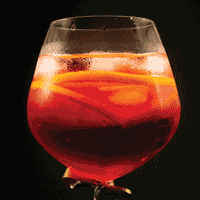The country’s top bartenders agree — gin’s in
Where to even begin with gin? The popular spirit has been in production in one crude form or another since at least the 11th century; it’s been praised for its restorative, medicinal qualities and bemoaned for being cheap, dangerous and illegal. It’s a contradictory spirit, and that’s probably why it’s remained relevant, through boom and bust, celebration and prohibition.
At its core, gin is remarkably simple. In its distilled form, it’s produced by the re-distillation of a neutral grain spirit, with added botanicals — traditionally juniper berries — which result in its recognizable zing. But, despite its simplicity, legendary producers across the globe such as James Burrough, founder of Beefeater Gin, took the profile farther. In fact, Burrough’s original 1876 recipe, calls for additional ingredients such as Seville orange peel, coriander seed and almond, plus orris, angelica and licorice root. Current Beefeater master distiller Desmond Payne added grapefruit peel and various Japanese and Chinese teas to his own rendition, when he created the premium Beefeater 24, in 2009.
And, that’s only speaking for the traditionalist, which says nothing of what can be loosely dubbed the New World gins. Premium creations such as Hendrick’s from Scotland, Aviation from Oregon and Victoria from B.C., follow some of the traditional blueprints but also add other unique flavours like rose petal and lavender, to give the liquid lighter, floral overtones.
“It’s the original flavoured vodka,” says Simon Kaulback, food and beverage manager at Vancouver’s über-hip Boneta, in Gastown, who uses various gins in a number of his restaurant’s top-rated cocktails. “Any bartender or proper cocktail mixologist will almost always prefer working with gin; it’s the king of spirits,” he says. “Just look at most old-school cocktail books. There are maybe two or three vodka drinks and literally hundreds of gin drinks.”
While gin, with its trademark pine tar punch, might seem like a one-trick pony, the key to Kaulback’s broad ranging cocktail program is making sure to have a wide selection of gins. Vodka, for instance, tastes similar from one maker to another, but gin is a completely different experience, notes the F&B manager. “If you actively go out and try different gins, you’ll be amazed at the different flavours and their effectiveness and suitability for one drink over another. That’s what’s
so great about it. You could walk into any bar and order a vodka soda, and it doesn’t matter what vodka you throw in the glass. Make gin and tonics, with three different gins, and you’re going to get two great drinks and one that’s horrible.”
How does Kaulback know which gin will work best in the stockstandard gin martini, the summer patio staple G ‘n’ T or his more creative offerings? Well, tragically, he has to try all of them. “The first thing I’ll do when I get a new gin is to make a classic gin martini — that’s my barometer. If I find the gin has more citrus and juniper coming through, indicative of the classic London Dry style, then it’s probably more suited to be the forerunner in a classic cocktail. But, if it’s one of the New World gins, which can be unique and have some different flavours, then I’ll play around with different mixes, to complement those unique notes,” he adds.
And, one needn’t look farther than the mouthwatering cocktail list at Boneta for examples of Kaulback’s mantra in motion. There, barkeeps are currently slinging classic Savoy-inspired bevies such as the Opera Cocktail, a juniper lover’s elixir of Beefeater gin, Dubonet Rouge, Maraschino Liqueur and orange bitters. Meanwhile, in the summer, a milder, more floral concoction of Hendrick’s gin, with its rose petal and cucumber notes, may be combined with green chartreuse, lime, honey and egg white to combat the heat.




















